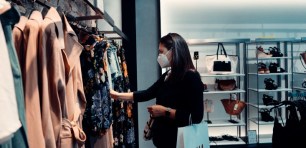
Source: AP/Asanka Brendon Ratnayake.
As global fashion weeks kicked off last month, we were all a little overwhelmed. Not only at seeing the next-levels of -craftsmanship and creativity to burst out of the pandemic, but also, by the return of events. In-person events.
Flying the Australian fashion flag high at the New York shows was Dion Lee, the only Australian fashion designer to show up and stomp the runway, despite some of the world’s biggest names — including Ralph Lauren, Marc Jacobs and Tom Ford — choosing not to attend. Then there were some brands who decided to ditch IRL entirely by showcasing their collections in the metaverse.
Retail has certainly changed, that is no secret. But fashion as a retail sector is in a league of its own; it isn’t just another shopping category or drop down menu on a website. It is artistry, innovation and above all, expression.
While thousands of businesses have switched to a digital permanent state, there will forever be a place for physical fashion, window shopping, runways, changing rooms and actually-on-the-street-style that might not only outlive the pending reign of the metaverse, but could also lead to a more sustainable fashion future.
Here are a few reasons that we need to keep the window shopper alive, and in person.
Our un-planet-friendly online shopping habits
Holding hands with the dot com boom is the Buy Now, Return Later (BNRL) revolution. Last year, online shopping was a saviour for many who relied on an almost daily delivery of large, plastic swag bags from ASOS to unwrap, sometimes just for something to do. And as a result, we have bred a culture of returns. Shopping during lockdown got out of hand for many, and few of us are not guilty of buying multiple pairs of the same jeans in different sizes, only to return them the following day.
What happened to the war on waste, people? The act of bulk buying garments that you would have normally dragged with you into a changing room is called ‘bracketing’ and trust us, it’s not a good look. Returning items in a physical store certainly has an economical impact on the business, but doing it from the comfort of our own homes also includes large amounts of plastic wrapping — including around every single item, zipper and button — not to mention the carbon footprint of the individual courier driver delivering it.
Sustainable fashion can no longer be shouted about by brands; it is also a hygiene factor. With younger generations demanding more accountability there is an exciting opportunity for those who are hearing the call, to reference this throughout their concept store in interesting ways. While there is a lot of focus on making the products, clothes, and production more sustainable, you rarely hear stores putting their money where their mouth is when it comes to a physical space.
But maybe they should.
It’s about the physical experience
The clue is in the main ingredient used within the fashion industry: textiles. Nothing beats the feeling of brand new denim, or the sound of a stiff shoe box opening for the first time. Textures and experience is a major miss among online shopping. Not to mention the full length mirror, complementary lighting and the salesperson desperate to make you look better than you could have possibly imagined.
With thousands of businesses launching online-only fashion outlets without any consideration or potential for in-person sales; they should take a look at some of the big guys who are doing the complete opposite.
Take GymShark, for example. In 2021, GymShark launched their first ever bricks and mortar store 10 years after its digital inception, in London’s central Regent Street, in what some considered to be a bold move for a new business.
But not only did GymShark strike while the iron was hot (demand for sportswear amid the pandemic exploded) but they also took into account the varying needs of their shoppers. The physical store didn’t disappoint, spanning three floors on London’s iconic Regent Street and signed a 10 year lease as a site that will not only be a store, but act as a brand-community hangout, a place for brand events and on-site workouts.
GymShark used a bricks and mortar space to create an in person location for their digital community.
Why window shopping will never cease
Excluding groceries, three in four Australians (75%) shop online. According to the latest Bureau of Statistics release, January 2022 exceeded expectations with a 1.8% increase in retail sales — the second highest monthly gain on record after last November’s end-of-lockdown boom.
However, while online shopping is clearly thriving, now that we’re learning to live with the virus, we’ve realised just how much we’ve missed trying on that dress IRL.
Outside of strict lockdowns, Australian shopping centres have come back with a bang. Whether it’s browsing and window shopping or picking up an item in store after doing all the research online, consumers are embracing the in-person shopping experience.
As the AFR’s Lauren Sams describes so well in her article, Why real-life shopping will always trump the metaverse: “For all the talk of the metaverse, and for all the convenience and ease of online shopping, there is still something beguiling and alluring about the in-store experience. I know the way I feel when I walk into my favourite boutiques, the way the salespeople know me by name, the way they can select garments they know I will love (they know my size, too). It’s special”.
The psychology of the in-person shopping experience, from discovery to the instant gratification of purchasing an item right then and there, simply can’t be replaced by the online experience — no matter how hard Mark Zuckerberg would like it to.
Clothing, especially in higher end and luxury stores, is all about small, particular details that you can only really experience in person. No matter how advanced augmented reality becomes, it’s never going to replicate the feeling of a fabric, or the feel of a garment as it hangs perfectly (or imperfectly) on your body.
Whether it’s saving the planet or simply finding that perfect dress, in-store shopping is going nowhere; no matter how many shoppers are still loving a cheeky online buy.
As we begin to learn to live with the virus, smart retailers will learn how to balance both.
Handpicked for you

COVID-19’s ‘new normal’ is anything but, with SMEs now navigating a multi-speed operating environment



COMMENTS
SmartCompany is committed to hosting lively discussions. Help us keep the conversation useful, interesting and welcoming. We aim to publish comments quickly in the interest of promoting robust conversation, but we’re a small team and we deploy filters to protect against legal risk. Occasionally your comment may be held up while it is being reviewed, but we’re working as fast as we can to keep the conversation rolling.
The SmartCompany comment section is members-only content. Please subscribe to leave a comment.
The SmartCompany comment section is members-only content. Please login to leave a comment.